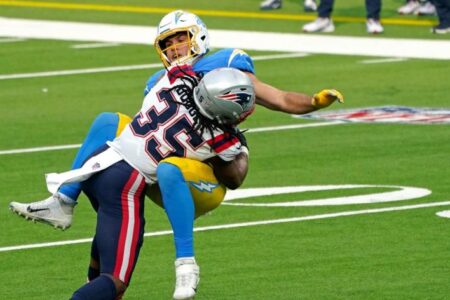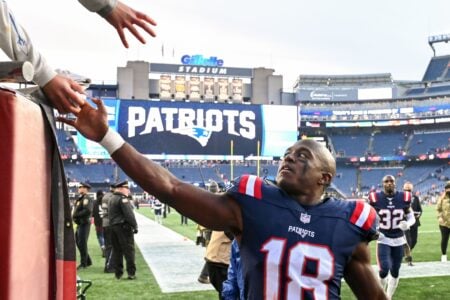To see where the Pats' offense and defense stand, here are our computer model results.
1- First, explanation of our model , Exhibit 1A shows Scoring Efficiency (ScEf) as a function of starting position of a drive (both offensive and defensive). It shows the mean point expected for a given drive position. The red curve is a simplified model based on NFL historical data; the green bar shows 2007 data of all teams except the Pats. For example, if an average NFL team starts 10 drives at 60 yards away from the EZ, they can expect to score 2x10=20 pts or given up 20 pts.
The most important part of the red curve is the range from -100 yrds to -50 yards, because most drives start in that range. Exh. 1B shows the distribution of drive-start positions. The black curve is the historical model, and the red bars are actual 2007 data.
To evaluate a team offense or defense, one way is to look at their ScEf for the -100 to -50 yd range. In Exh. 1A, the dashed blue curve shows the model for a good offense (high scoring efficiency) and bad defense (high allowed score); Conversely, the dashed red curve shows a bad offense and a good defense.
2- The Pats offense is shown in Exh. 2A and 2B. The ScEf (blue curve) is totally out of this world. They can score almost from any position. The curve was even more amazing before the Eagles and Raven games. The rating has gone down, but still very good. Exhibit 2B shows their actual drive starting positions. In fact, their average score per drive is ~3.4 and given that they have ~ 12 drives/game, they can score ~41 points as expected.
3- The Pats defense is shown in Exh. 3A and 3B. It has been known to us for a while that the Pats D is just a tad better than mediocre, as the purple curve (actual data) is near the red curve (but below). But these data need to be adjusted for opportunities: because the Pats' offense is so good, there were less time and opportunities for the opposite offense. Our opp-adjusted data is shown as the brown dots, which is indeed slightly sub-par (which raised the flag on the Pats D long before the Eagles and Ravens' games).
Even worse, the computer model (black curve) indicates that the Pats' defense is slightly below 2007 NLF average. It is NOT based on actual scoring data, but only from a model based on actual plays (regardless of scores). Before the Eagles and Ravens' games, one can dismiss the black curve as a computer model deficiency (which is fair and probable). But after the last two games, it agrees well with the adjusted scoring data (brown dots).
For reference, Exh. 3B shows the actual Pats' defensive series distribution. We can dismissed their poor performance (the spike in Exh. 3A) in the range from -30 yards and less as statistically insignificant, because there are so few drives there. But the black curve shoots up near there, which is ominous.
Epilogue May be the Pats' D will improve in time.
May be these models are still inaccurate with insufficient statistics.
May be AJ Feeley and K Boller happened to have the performance of their lives. While it is nice to give people deserved credit, it can be self-deceptive to ignore the facts that these guys are pumpkins outside the Pats games. It is equally probable that they are as bad as their records say (Phila lost to Seattle and I'm not holding my breath for the Ravens to beat the Colts) and accept the inference that the Pats' D is simply as bad as the computer model has been suggesting all along.
What I know is that some people bet against the Pats (taking the huge home underdog Ravens) based on this model and win big. I didn't want to bet against the Pats. But I couldn't stop others from laughing their way to the bank.
Caveat: people and team can improve and I surely hope so for the Pats. But it's a downward spiral right now. Computer rating such as Sagarin's (which I disagree with the method) had the Pats ~ 42+ points before the Eagles game and dropped to ~40, and now ~39 after the Ravens. Our model does not rate with a single number like that, but it shows a significant drop also.
The Pats' defense also has a larger variation than average. It means they can be very good in one game and awful in another. This is different from the Pat's offense, which has a narrower performance range.
1- First, explanation of our model , Exhibit 1A shows Scoring Efficiency (ScEf) as a function of starting position of a drive (both offensive and defensive). It shows the mean point expected for a given drive position. The red curve is a simplified model based on NFL historical data; the green bar shows 2007 data of all teams except the Pats. For example, if an average NFL team starts 10 drives at 60 yards away from the EZ, they can expect to score 2x10=20 pts or given up 20 pts.
The most important part of the red curve is the range from -100 yrds to -50 yards, because most drives start in that range. Exh. 1B shows the distribution of drive-start positions. The black curve is the historical model, and the red bars are actual 2007 data.
To evaluate a team offense or defense, one way is to look at their ScEf for the -100 to -50 yd range. In Exh. 1A, the dashed blue curve shows the model for a good offense (high scoring efficiency) and bad defense (high allowed score); Conversely, the dashed red curve shows a bad offense and a good defense.
2- The Pats offense is shown in Exh. 2A and 2B. The ScEf (blue curve) is totally out of this world. They can score almost from any position. The curve was even more amazing before the Eagles and Raven games. The rating has gone down, but still very good. Exhibit 2B shows their actual drive starting positions. In fact, their average score per drive is ~3.4 and given that they have ~ 12 drives/game, they can score ~41 points as expected.
3- The Pats defense is shown in Exh. 3A and 3B. It has been known to us for a while that the Pats D is just a tad better than mediocre, as the purple curve (actual data) is near the red curve (but below). But these data need to be adjusted for opportunities: because the Pats' offense is so good, there were less time and opportunities for the opposite offense. Our opp-adjusted data is shown as the brown dots, which is indeed slightly sub-par (which raised the flag on the Pats D long before the Eagles and Ravens' games).
Even worse, the computer model (black curve) indicates that the Pats' defense is slightly below 2007 NLF average. It is NOT based on actual scoring data, but only from a model based on actual plays (regardless of scores). Before the Eagles and Ravens' games, one can dismiss the black curve as a computer model deficiency (which is fair and probable). But after the last two games, it agrees well with the adjusted scoring data (brown dots).
For reference, Exh. 3B shows the actual Pats' defensive series distribution. We can dismissed their poor performance (the spike in Exh. 3A) in the range from -30 yards and less as statistically insignificant, because there are so few drives there. But the black curve shoots up near there, which is ominous.
Epilogue May be the Pats' D will improve in time.
May be these models are still inaccurate with insufficient statistics.
May be AJ Feeley and K Boller happened to have the performance of their lives. While it is nice to give people deserved credit, it can be self-deceptive to ignore the facts that these guys are pumpkins outside the Pats games. It is equally probable that they are as bad as their records say (Phila lost to Seattle and I'm not holding my breath for the Ravens to beat the Colts) and accept the inference that the Pats' D is simply as bad as the computer model has been suggesting all along.
What I know is that some people bet against the Pats (taking the huge home underdog Ravens) based on this model and win big. I didn't want to bet against the Pats. But I couldn't stop others from laughing their way to the bank.
Caveat: people and team can improve and I surely hope so for the Pats. But it's a downward spiral right now. Computer rating such as Sagarin's (which I disagree with the method) had the Pats ~ 42+ points before the Eagles game and dropped to ~40, and now ~39 after the Ravens. Our model does not rate with a single number like that, but it shows a significant drop also.
The Pats' defense also has a larger variation than average. It means they can be very good in one game and awful in another. This is different from the Pat's offense, which has a narrower performance range.
Attachments
Last edited:





















